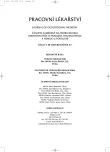Contribution to the Study of Factors Influencing the Serum Level of Aluminium in Adults
Authors:
J. Valachová; R. Mikulková; J. Buchancová
Authors‘ workplace:
Klinika pracovného lekárstva a toxikológie JLF UK a MFN Martin
vedúci pracoviska prof. MUDr. Jana Buchancová, CSc.
Published in:
Pracov. Lék., 57, 2005, No. 3, s. 109-113.
Category:
Original Papers
Overview
The authors were studying the relationship between the age and the serum level of aluminium in the adult population. Other factors might be dialysis and the duration of dialysis in the group of dialyzed patients. It is well known that the risk group of predominantly older adults may be at risk of increased nonprofessional exposure of aluminium.
The authors present the results of biological exposure tests of an aluminium serum level in dialyzed patients from 7 dialysis centres from Central and Northern Slovakia obtained in last four years. The aim of the study was also to evaluate the rate and persistence of an aluminium intoxication risk. 445 analyses of an aluminium serum level were undertaken in dialyzed patients in the course of the period 1999–2002. The average age of patients was 57,16 ± 12,07 years and the average time of exposure (years of dialysis) was 3,70 ± 2,41 years (x– ± SD). Another group comprised 30 adults aged 45,63 ± 7,10 years without nephrological disease. The nuclear absorption spectrophotometer SpectraAA with the electrothermic thermization of the sample in a graphite shallow dish at the temperature of 2700 °C was used for analysis.
98 % samples had an adequate concentration up to 2,224 μmol . l⁻¹which is a reference value for dialyzed patients requiered by the Commission of European Community (CEC). Wereas, 6 patients exceeded this value in 1999, none of patients exceeded it in 2002. The values of average concentrations of aluminium in serum were declining in the long term run (0,901 ± 0,49 μmol . l⁻¹ in 1999, 0,518 ± 0,22 μmol . l⁻¹ in 2002 – x– ± SD). In the follow-up period 1999–2002, there were increased values of aluminium above a reference values of the CEC in 8 dialyzed patients, in 2 of the values of aluminium above 7,413 μmol . l⁻¹ were repeatedly measured and indicated the intoxication and the need of the treatment due to the high depot of aluminium in the organism.
The results did not show any correlation with age, nor the duration of dialysis in dialyzed patients. Monitoring of aluminium in serum of dialyzed patients is justified and may prevent further serious deterioration of health from aluminium.
Key words:
aluminium in serum, adults, dialyzed patients, age, toxicity
Labels
Hygiene and epidemiology Hyperbaric medicine Occupational medicineArticle was published in
Occupational Medicine

2005 Issue 3
Most read in this issue
- Arthrosis of Joints of Extremities as an Occupational Disease
- Professional Entesopathy of an Elbow Joint
- Occupational Dieseases and Endangered Occupational Diseases Notified in the Czech Republic in 2004
- Characteristics of Surface Layer of Chromium Cobalt Alloy Coated with Titanium Nitride and Zirconium Nitride
